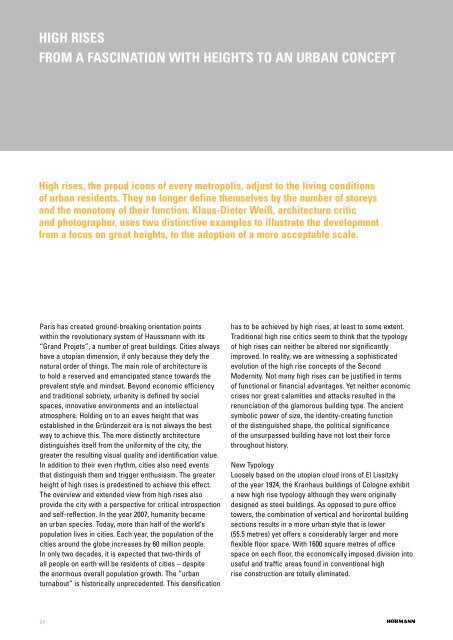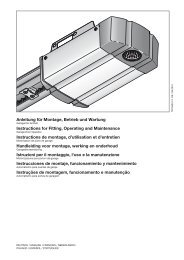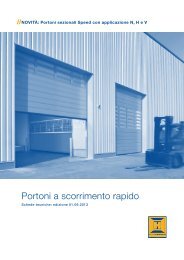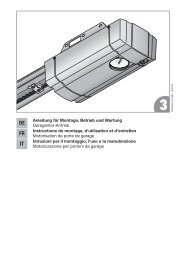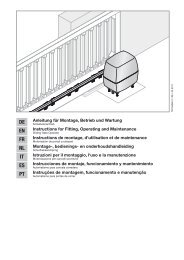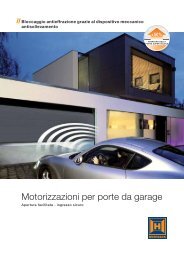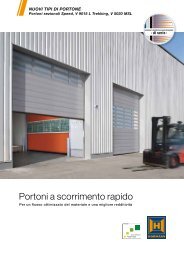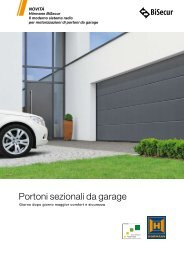Download as PDF - Garage doors
Download as PDF - Garage doors
Download as PDF - Garage doors
You also want an ePaper? Increase the reach of your titles
YUMPU automatically turns print PDFs into web optimized ePapers that Google loves.
High rises<br />
From a f<strong>as</strong>cination with heights to an urban concept<br />
High rises, the proud icons of every metropolis, adjust to the living conditions<br />
of urban residents. They no longer define themselves by the number of storeys<br />
and the monotony of their function. Klaus-Dieter Weiß, architecture critic<br />
and photographer, uses two distinctive examples to illustrate the development<br />
from a focus on great heights, to the adoption of a more acceptable scale.<br />
Paris h<strong>as</strong> created ground-breaking orientation points<br />
within the revolutionary system of Haussmann with its<br />
“Grand Projets”, a number of great buildings. Cities always<br />
have a utopian dimension, if only because they defy the<br />
natural order of things. The main role of architecture is<br />
to hold a reserved and emancipated stance towards the<br />
prevalent style and mindset. Beyond economic efficiency<br />
and traditional sobriety, urbanity is defined by social<br />
spaces, innovative environments and an intellectual<br />
atmosphere. Holding on to an eaves height that w<strong>as</strong><br />
established in the Gründerzeit era is not always the best<br />
way to achieve this. The more distinctly architecture<br />
distinguishes itself from the uniformity of the city, the<br />
greater the resulting visual quality and identification value.<br />
In addition to their even rhythm, cities also need events<br />
that distinguish them and trigger enthusi<strong>as</strong>m. The greater<br />
height of high rises is predestined to achieve this effect.<br />
The overview and extended view from high rises also<br />
provide the city with a perspective for critical introspection<br />
and self-reflection. In the year 2007, humanity became<br />
an urban species. Today, more than half of the world‘s<br />
population lives in cities. Each year, the population of the<br />
cities around the globe incre<strong>as</strong>es by 60 million people.<br />
In only two decades, it is expected that two-thirds of<br />
all people on earth will be residents of cities – despite<br />
the enormous overall population growth. The “urban<br />
turnabout” is historically unprecedented. This densification<br />
h<strong>as</strong> to be achieved by high rises, at le<strong>as</strong>t to some extent.<br />
Traditional high rise critics seem to think that the typology<br />
of high rises can neither be altered nor significantly<br />
improved. In reality, we are witnessing a sophisticated<br />
evolution of the high rise concepts of the Second<br />
Modernity. Not many high rises can be justified in terms<br />
of functional or financial advantages. Yet neither economic<br />
crises nor great calamities and attacks resulted in the<br />
renunciation of the glamorous building type. The ancient<br />
symbolic power of size, the identity-creating function<br />
of the distinguished shape, the political significance<br />
of the unsurp<strong>as</strong>sed building have not lost their force<br />
throughout history.<br />
New Typology<br />
Loosely b<strong>as</strong>ed on the utopian cloud irons of El Lissitzky<br />
of the year 1924, the Kranhaus buildings of Cologne exhibit<br />
a new high rise typology although they were originally<br />
designed <strong>as</strong> steel buildings. As opposed to pure office<br />
towers, the combination of vertical and horizontal building<br />
sections results in a more urban style that is lower<br />
(55.5 metres) yet offers a considerably larger and more<br />
flexible floor space. With 1600 square metres of office<br />
space on each floor, the economically imposed division into<br />
useful and traffic are<strong>as</strong> found in conventional high<br />
rise construction are totally eliminated.<br />
04


